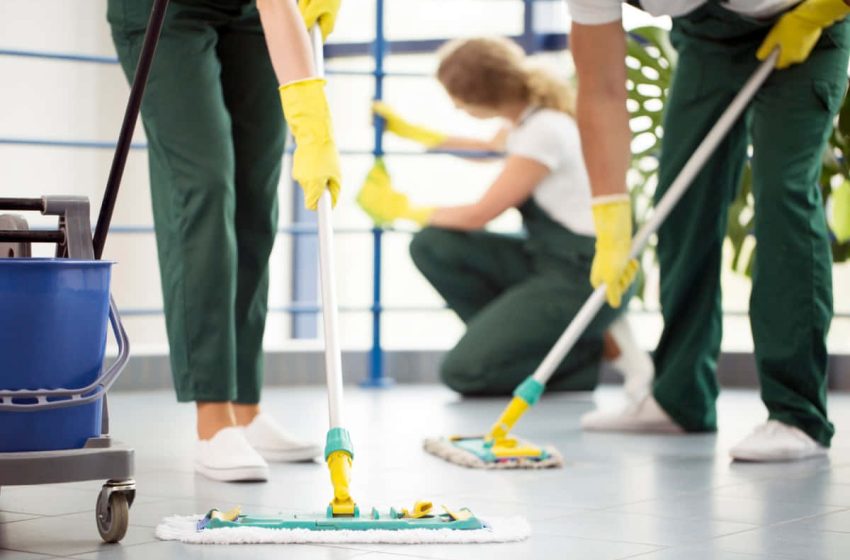Here’s What Not to Do When Cleaning Your Home
- Business
 common man
common man- May 20, 2024
- 61

Cleaning your home is an essential task that ensures a healthy and pleasant living environment. However, there are numerous common mistakes people make that can undermine their efforts, waste time, and even cause damage to their homes. Understanding what not to do when cleaning can help you avoid these pitfalls and achieve more efficient and effective results. This comprehensive guide explores the most frequent cleaning mistakes and provides insights on how to avoid them.
Using the Wrong Cleaning Products
Using the wrong cleaning products is one of the most common mistakes people make when cleaning their homes. Each surface and material in your home requires specific types of cleaners to avoid damage and achieve the best results. For example, using a glass cleaner on wood surfaces can strip the finish and cause discoloration. Similarly, using abrasive cleaners on delicate surfaces like marble or granite can cause scratches and permanent damage.
Always read the labels on cleaning products to ensure they are suitable for the surfaces you are cleaning. If in doubt, perform a patch test on a small, inconspicuous area to check for any adverse reactions before applying the product more broadly. Additionally, consider using natural or homemade cleaning solutions for a safer and more eco-friendly approach.
Ignoring the Manufacturer’s Instructions
Many cleaning tools and appliances come with manufacturer instructions that provide important information on their proper use and maintenance. Ignoring these instructions can lead to ineffective cleaning, damage to the equipment, and even safety hazards. For instance, using a vacuum cleaner without regularly cleaning or replacing the filters can reduce its efficiency and lead to overheating.
Take the time to read and follow the manufacturer’s instructions for all your cleaning tools and appliances. This ensures that you are using them correctly and maintaining them properly, which prolongs their lifespan and enhances their performance.
Overlooking Safety Precautions
Cleaning can involve the use of chemicals and equipment that pose safety risks if not handled properly. Common safety mistakes include mixing cleaning products that should not be combined, such as bleach and ammonia, which can create toxic fumes. Another frequent error is neglecting to wear protective gear like gloves, masks, and eye protection when using harsh chemicals.
To avoid these risks, always read and follow the safety instructions on cleaning product labels. Store cleaning products out of reach of children and pets, and ensure proper ventilation when using chemicals. Wearing appropriate protective gear and taking necessary precautions can prevent accidents and health issues.
Cleaning in the Wrong Order
The order in which you clean your home can significantly impact the effectiveness of your efforts. Cleaning floors before dusting furniture, for example, can result in dust and debris falling onto freshly cleaned floors, necessitating additional cleaning. Similarly, cleaning windows before dusting can lead to streaks and smudges from settled dust.
To maximize efficiency, follow a logical cleaning sequence. Start with tasks that generate dust and debris, such as dusting and vacuuming, and finish with tasks that involve wet cleaning, such as mopping floors and cleaning windows. This approach ensures that you do not undo your cleaning efforts and achieve a thorough clean.
Neglecting High-Touch Areas
High-touch areas, such as light switches, doorknobs, remote controls, and faucet handles, are often overlooked during routine cleaning. These areas harbor a high concentration of germs and bacteria due to frequent contact and should be regularly disinfected to maintain a healthy environment.
Make it a habit to include high-touch areas in your cleaning routine. Use disinfectant wipes or sprays to clean these surfaces, and pay particular attention during cold and flu season or when someone in the household is ill.
Using Dirty Cleaning Tools
Using dirty cleaning tools is counterproductive and can spread dirt and bacteria rather than remove them. Common examples include using a mop with a dirty head, a vacuum cleaner with a full or clogged filter, or a sponge that has not been properly sanitized.
Regularly clean and maintain your cleaning tools to ensure they remain effective. Replace sponges and mop heads as needed, and clean vacuum filters and brushes according to the manufacturer’s recommendations. By keeping your tools clean, you enhance their performance and ensure a more thorough cleaning process.
Skipping Routine Maintenance
Routine maintenance is essential to keep your home in good condition and prevent dirt and grime from building up over time. Skipping regular cleaning tasks, such as vacuuming, dusting, and cleaning appliances, can lead to more challenging and time-consuming cleaning sessions in the future.
Establish a cleaning schedule that includes daily, weekly, and monthly tasks to stay on top of maintenance. Regular upkeep not only makes cleaning more manageable but also helps maintain a clean and healthy home environment.
Overloading Cleaning Products
More is not always better when it comes to cleaning products. Using too much cleaner can leave behind residues that attract dirt and create a sticky surface. This is particularly true for floor cleaners, where excess product can make floors slippery and dangerous.
Follow the recommended amounts on cleaning product labels and avoid the temptation to overuse. For many products, a little goes a long way, and using the appropriate amount will provide effective results without leaving unwanted residues.
Not Allowing Cleaners to Sit
Many cleaning products need time to work effectively. Spraying a cleaner and immediately wiping it off can reduce its effectiveness, especially for disinfectants and stain removers that require a certain dwell time to break down dirt and kill germs.
Read the instructions on your cleaning products to determine the recommended dwell time. Allowing cleaners to sit for the appropriate amount of time ensures they can work effectively, making your cleaning efforts more efficient and successful.
Scrubbing Stains Aggressively
When faced with stubborn stains, the instinct may be to scrub vigorously in an attempt to remove them. However, aggressive scrubbing can damage surfaces and fabrics, making the problem worse. For example, scrubbing carpets too hard can fray the fibers, and scrubbing painted surfaces can remove the paint.
Instead of scrubbing aggressively, use the correct stain removal techniques and products for the specific type of stain and surface. Blot stains on fabrics and carpets gently, and use appropriate stain removers for different types of stains. Patience and the right approach will yield better results without causing damage.
Using One Cloth for Everything
Using the same cloth to clean multiple surfaces is a common mistake that can spread dirt and bacteria around your home. This practice is particularly problematic when cleaning high-germ areas such as bathrooms and kitchens, where cross-contamination can occur.
Use different cloths for different areas and tasks, and color-code them if possible to avoid confusion. For example, designate specific cloths for the bathroom, kitchen, and general dusting. Wash and disinfect cloths regularly to maintain their cleanliness and effectiveness.
Overlooking Air Vents and Filters
Air vents and filters play a crucial role in maintaining indoor air quality, but they are often overlooked during cleaning. Neglecting these areas can lead to dust buildup and reduced efficiency of heating and cooling systems. Dirty air filters can also circulate allergens and pollutants throughout your home.
Include air vents and filters in your regular cleaning routine. Vacuum or dust air vents and replace or clean filters according to the manufacturer’s recommendations. Maintaining clean air vents and filters helps improve indoor air quality and ensures the efficient operation of your HVAC system.
Neglecting Behind and Under Furniture
Areas behind and under furniture are often neglected because they are out of sight and require extra effort to reach. However, these areas can accumulate dust, dirt, and allergens, contributing to a less clean home environment.
Make it a point to move furniture periodically and clean behind and underneath it. Use a vacuum with a long hose attachment or a dusting tool to reach these hidden areas. Regularly cleaning behind and under furniture helps maintain a cleaner home and reduces the buildup of dust and allergens.
Forgetting to Clean Cleaning Appliances
Cleaning appliances, such as dishwashers, washing machines, and vacuum cleaners, need regular cleaning to function effectively. Neglecting to clean these appliances can lead to reduced efficiency and the spread of bacteria and odors.
Follow the manufacturer’s instructions for cleaning and maintaining your appliances. Run cleaning cycles for dishwashers and washing machines using appropriate cleaning agents, and regularly empty and clean vacuum cleaner bags, filters, and brushes. Keeping your cleaning appliances clean ensures they operate at their best and extend their lifespan.
Improper Disposal of Cleaning Products
Improper disposal of cleaning products can harm the environment and pose safety risks. Pouring chemicals down the drain, throwing them in the trash, or mixing them with other substances can lead to pollution and hazardous reactions.
Dispose of cleaning products according to local regulations and guidelines. Many communities have designated disposal sites for hazardous waste, including cleaning chemicals. Proper disposal protects the environment and ensures the safety of your household and community.
Using Too Much Water on Wood Floors
Water is a common enemy of wood floors, causing warping, swelling, and damage over time. Using excessive water when cleaning wood floors can lead to these issues, compromising the appearance and integrity of the flooring.
Use a damp, not wet, mop or cloth when cleaning wood floors, and immediately dry any excess moisture. Opt for cleaning products specifically designed for wood floors, and avoid using steam cleaners, which can introduce too much moisture. Proper care and minimal water use will help preserve the beauty and longevity of your wood floors.
Not Cleaning from Top to Bottom
Cleaning from the bottom up can result in dirt and dust falling onto areas that have already been cleaned, requiring additional effort. For example, dusting lower shelves before higher ones can lead to dust settling on the freshly cleaned surfaces below.
Always clean from top to bottom to avoid this issue. Start with high surfaces such as shelves, cabinets, and light fixtures, and work your way down to lower surfaces like countertops and floors. This method ensures that any dust or debris displaced during cleaning falls to areas that are yet to be cleaned.
Overlooking Light Fixtures and Ceiling Fans
Light fixtures and ceiling fans are often neglected during regular cleaning, leading to the buildup of dust and dirt. Dusty light fixtures can reduce the brightness of your lighting, and dirty ceiling fans can circulate dust throughout your home.
Include light fixtures and ceiling fans in your cleaning routine. Use a microfiber cloth or duster to remove dust from these areas, and periodically clean the blades of ceiling fans to prevent dust accumulation. Regularly cleaning these fixtures enhances the cleanliness and air quality of your home.
Neglecting Upholstery and Curtains
Upholstery and curtains can accumulate dust, allergens, and odors over time, yet they are often overlooked in routine cleaning. Neglecting these areas can contribute to a less clean and healthy home environment.
Vacuum upholstery and curtains regularly using appropriate attachments, and consider professional cleaning for deeper maintenance. Spot clean stains on upholstery promptly to prevent them from setting in. Keeping upholstery and curtains clean enhances the overall cleanliness and freshness of your home.
Using Harsh Chemicals on Delicate Surfaces
Harsh chemicals can cause damage to delicate surfaces such as granite, marble, stainless steel, and certain types of flooring. Using the wrong cleaner can result in scratches, discoloration, and other forms of damage.
Use cleaning products specifically designed for delicate surfaces, and opt for gentle, non-abrasive cleaners whenever possible. Test new products on a small, inconspicuous area before applying them to the entire surface. This approach protects your home’s surfaces and ensures their longevity.
Cleaning Windows on a Sunny Day
Cleaning windows on a sunny day can cause the cleaning solution to dry too quickly, leading to streaks and spots. The heat from the sun accelerates the drying process, making it difficult to achieve a streak-free finish.
Choose a cloudy day or clean windows in the early morning or late afternoon when the sun is not directly shining on them. This allows the cleaning solution to work effectively without drying too quickly, resulting in clearer, streak-free windows.
Ignoring the Vacuum’s Height Setting
Vacuum cleaners often come with adjustable height settings to accommodate different types of flooring, such as carpet, hardwood, and tile. Ignoring these settings can reduce the vacuum’s effectiveness and potentially damage your floors.
Adjust the vacuum’s height setting according to the type of flooring you are cleaning. Lower settings are typically suitable for carpets, while higher settings work better for hard floors. Using the correct setting ensures optimal cleaning performance and protects your floors from damage.
Overloading the Dishwasher
Overloading the dishwasher can prevent dishes from getting properly cleaned and can cause damage to the appliance. Crowded dishes may block the spray arms and prevent water and detergent from reaching all surfaces.
Load the dishwasher according to the manufacturer’s guidelines, ensuring that there is enough space between dishes for water and detergent to circulate freely. Avoid stacking items on top of each other and ensure that larger items do not obstruct the spray arms. Proper loading enhances the dishwasher’s efficiency and ensures that your dishes come out clean.
Neglecting Baseboards and Trim
Baseboards and trim often accumulate dust and dirt but are frequently overlooked during regular cleaning. Neglecting these areas can detract from the overall cleanliness of your home and contribute to the buildup of allergens.
Include baseboards and trim in your cleaning routine. Use a microfiber cloth or a vacuum with a brush attachment to remove dust and dirt. Periodically wipe them down with a damp cloth and a mild cleaner to maintain their appearance and cleanliness.
Using the Wrong Cleaning Technique
Using the wrong cleaning technique can be ineffective and even damaging. For example, scrubbing a surface with a harsh brush can cause scratches, while using circular motions to clean windows can leave streaks.
Learn and apply the correct cleaning techniques for different surfaces and tasks. For instance, use a squeegee in a vertical or horizontal motion to clean windows, and use a gentle blotting motion to clean stains on carpets. Proper techniques ensure effective cleaning without causing damage.
Not Rinsing Surfaces Properly
Failing to rinse surfaces properly after cleaning can leave behind residues that attract dirt and cause streaks or film buildup. This is especially important for surfaces like countertops, floors, and tiles.
After applying a cleaning solution, thoroughly rinse the surface with clean water and dry it with a clean cloth. This removes any remaining cleaning product and ensures a streak-free, residue-free finish. Proper rinsing enhances the cleanliness and appearance of your surfaces.
Ignoring Regular Maintenance of Appliances
Regular maintenance of household appliances is crucial for their longevity and efficiency. Neglecting this maintenance can lead to reduced performance, higher energy consumption, and potential breakdowns.
Follow the manufacturer’s recommendations for maintaining appliances such as refrigerators, ovens, washing machines, and dryers. This may include cleaning coils, filters, and seals, as well as scheduling professional servicing as needed. Regular maintenance ensures that your appliances run efficiently and last longer.
Cleaning with a Dirty Mop or Sponge
Using a dirty mop or sponge spreads dirt and bacteria rather than removing them. This common mistake can make your cleaning efforts less effective and even introduce new contaminants to your home.
Regularly clean and sanitize mops and sponges to ensure they are effective tools for cleaning. Replace them as needed to maintain hygiene. Using clean tools helps ensure that you are effectively removing dirt and bacteria, resulting in a truly clean home.
Not Letting Floors Dry Completely
Not allowing floors to dry completely after cleaning can lead to slips and falls and can also attract dirt and dust to the wet surface. This is particularly important for areas with high foot traffic.
After mopping, ensure that floors have adequate time to dry completely before walking on them. Use fans or open windows to speed up the drying process if necessary. Allowing floors to dry properly ensures safety and maintains the cleanliness of the surface.
Skipping Professional Cleaning Services
While regular home cleaning is essential, there are times when professional cleaning service company Charlotte, NC can provide a deeper, more thorough clean. Skipping professional cleaning services can result in missed areas and buildup of dirt and grime over time.
Consider scheduling professional cleaning services for tasks such as carpet cleaning, upholstery cleaning, and deep cleaning of kitchens and bathrooms. Professional cleaners have the tools and expertise to tackle stubborn dirt and provide a level of cleanliness that is difficult to achieve with regular home cleaning.
Conclusion
Cleaning your home is a crucial task that requires attention to detail and proper techniques to ensure effective results. By understanding what not to do when cleaning, you can avoid common mistakes that undermine your efforts and cause damage. Use the right cleaning products, follow manufacturer instructions, prioritize safety, and maintain a regular cleaning routine to keep your home clean and healthy. By adopting these best practices, you can achieve a more efficient and effective cleaning process, resulting in a cleaner and more comfortable living environment.


